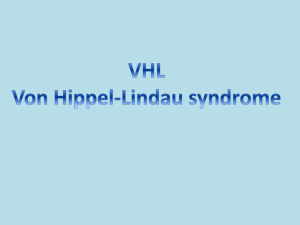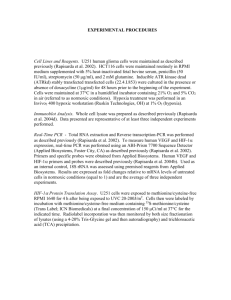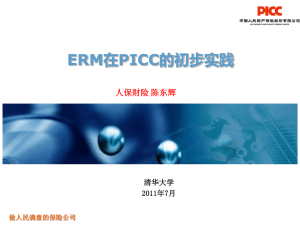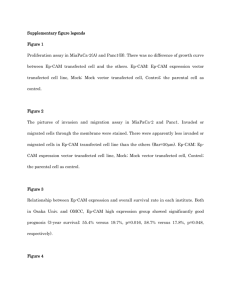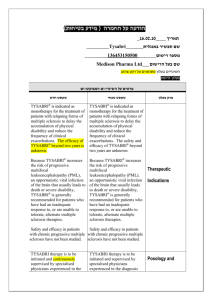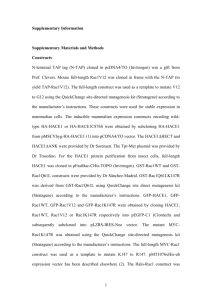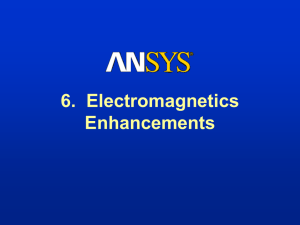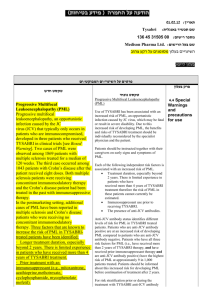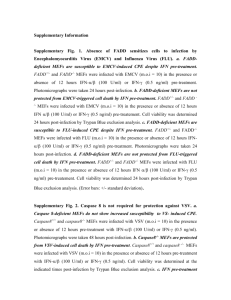Supplementary Methods
advertisement
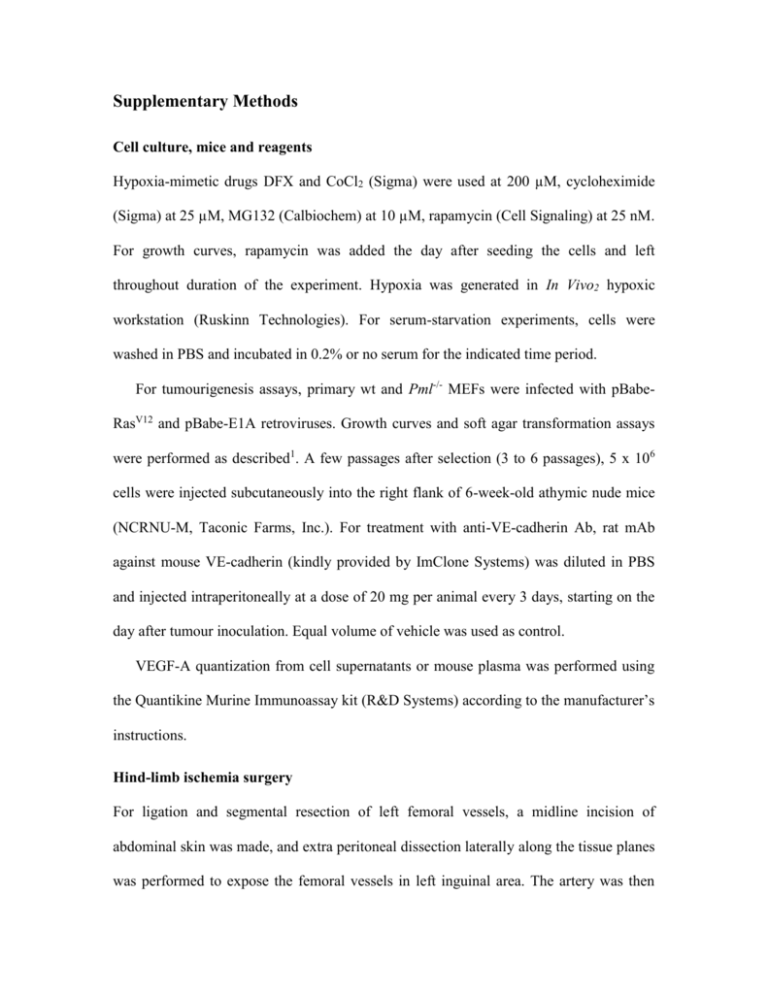
Supplementary Methods Cell culture, mice and reagents Hypoxia-mimetic drugs DFX and CoCl2 (Sigma) were used at 200 µM, cycloheximide (Sigma) at 25 µM, MG132 (Calbiochem) at 10 µM, rapamycin (Cell Signaling) at 25 nM. For growth curves, rapamycin was added the day after seeding the cells and left throughout duration of the experiment. Hypoxia was generated in In Vivo2 hypoxic workstation (Ruskinn Technologies). For serum-starvation experiments, cells were washed in PBS and incubated in 0.2% or no serum for the indicated time period. For tumourigenesis assays, primary wt and Pml-/- MEFs were infected with pBabeRasV12 and pBabe-E1A retroviruses. Growth curves and soft agar transformation assays were performed as described1. A few passages after selection (3 to 6 passages), 5 x 106 cells were injected subcutaneously into the right flank of 6-week-old athymic nude mice (NCRNU-M, Taconic Farms, Inc.). For treatment with anti-VE-cadherin Ab, rat mAb against mouse VE-cadherin (kindly provided by ImClone Systems) was diluted in PBS and injected intraperitoneally at a dose of 20 mg per animal every 3 days, starting on the day after tumour inoculation. Equal volume of vehicle was used as control. VEGF-A quantization from cell supernatants or mouse plasma was performed using the Quantikine Murine Immunoassay kit (R&D Systems) according to the manufacturer’s instructions. Hind-limb ischemia surgery For ligation and segmental resection of left femoral vessels, a midline incision of abdominal skin was made, and extra peritoneal dissection laterally along the tissue planes was performed to expose the femoral vessels in left inguinal area. The artery was then ligated both proximally and distally using 6-0 silk sutures and the ligated vessels were resected between the ligatures without damaging the nervus femoralis. The midline incision was then closed using 4-0 polysorb sutures. Rate of blood flow was measured with a digital Laser Doppler flowmeter (Model ALF21, Advance Co.) every three days in both the ischemic and non-ischemic hind-limbs of the same animal and ratios were calculated. Plasmids, cell transfection and transactivation assays pCMV-Tag2B-PML-IV was described2. pCDNA3-HIF-1 contains full-length human HIF-1 cDNA. HRE-luciferase (HRE-luc) contains three copies of the hypoxia response element (HRE) of the phosphoglycerate kinase (PGK) gene cloned in pGL2 basic (Promega). For luciferase assays with Dual Luciferase Reporter Assay System (Promega), H1299 cells were transfected with 200 ng HRE-luc and 54, 107 and 252 ng PML, with or without 20 ng HIF-1. Renilla expressing plasmid (10 ng) was cotransfected to normalize for transfection efficiency. Luciferase activity was assayed 48 hours post transfection. Primary MEFs were transfected with 500 ng HRE-luc and assayed as H1299 cells. MycRheb was from K. Guan. Transient transfections were performed with Effectene transfection reagent (Qiagen). For co-IP experiments, HEK-293 cells were transfected with 2 µg Myc-Rheb ± 3 µg Flag-PML. siRNA oligonucleotides for PML (5’AAGCACGAAGACAGACCTCTGG-3’ and 5’-AACGACAGCCCAGAAGAGGAA3’)3 and control oligos (Lamin A/C siRNA oligonucleotides purchased from Dharmacon) were transfected with Lipofectamine 2000 (Invitrogen). wt-SK6 and rapamycin-insensitive-S6K plasmids were a kind gift of G. Thomas. Real-time PCR Quantitative real-time PCR for Redd1 and hprt were performed on the Roche LightCycler using light cycler DNA Master SYBR Green I (Roche). Primers sets were: Redd1 Fwd (5’-CGAACTCCGGCCGCTGATCG-3’); Redd1 Rev (5’-CAATCGCGCCTGGGACAGGC-3’); hprt Fwd (5’-CCTGCTGGATTACATTAAAGCACT-3’); hprt Rev (5’-GTCAAGGGCATATCCAACAACAAA-3’). Western blotting The following antibodies were used: anti-mouse Hif-1 (Novus Biologicals and Simon laboratory); anti-human HIF-1 (BD Transduction Laboratories); anti-FLAG (Sigma); anti-Myc, anti-P-S6K (T389), anti-S6K, anti-PS6 (S235/236), anti-S6, anti-P-4EBP1 (T37/46), anti-4EBP1, anti P-Akt (S473), anti-Akt, anti-mTOR (Cell Signaling); antiTsc2 (Santa Cruz); anti-human PML: PG-M3 (Santa Cruz) and rabbit anti-PML (Chemicon), anti-mouse PML: S36 and S37 monoclonal antibodies (kindly provided by Dr. S. Lowe); anti- -actin (Sigma); anti-Hsp90 (BD Transduction Laboratories); anti laminB1 (AbCam); anti--tubulin (Sigma); anti-Rheb (. Anti-Redd1 was a gift from Dr. J. Kaufmann. TMA analysis For analysis of human tumours, the study cohort was comprised of 99 primary and 51 metastatic prostate tumour biopsies. The patients were treated and followed at Memorial Sloan-Kettering Cancer Center and tumour samples were collected at the time of surgical resection with written informed consent. Tumour tissue microarray preparation, PML (Santa Cruz) and CD34 staining (Dako) were performed as previously described4. PML scoring system was based on counting PML-NBs in tumour cells as follows: no NBs=0; few NBs (2 or fewer)=1; normal number of NBs (10-20)=2. Staining of endothelial cells for CD34 was used to calculate microvessel density. CD34 positive clusters of cells were counted as single microvessels, while larger vessels were not counted. Cases that had more than 50% of the core composed of tumor cells were analyzed. The scoring system we utilized is: 0-2 vessels=0; 2-5 vessels=1; >5 vessels=2 per 20 x field. Statistical evaluation Averaged data was analyzed for statistical significance by Student’s t-Test. Single nonaveraged values were compared separately for each time point. To compare PML and CD34 staining scores, Pearson Chi-Square correlation was calculated with SPSS software (version 11). Supplementary References 1. 2. 3. 4. Grisendi, S. et al. Role of nucleophosmin in embryonic development and tumorigenesis. Nature 437, 147-53 (2005). Bernardi, R. et al. PML regulates p53 stability by sequestering Mdm2 to the nucleolus. Nat Cell Biol 6, 665-72 (2004). Xu, Z. X., Timanova-Atanasova, A., Zhao, R. X. & Chang, K. S. PML colocalizes with and stabilizes the DNA damage response protein TopBP1. Mol Cell Biol 23, 4247-56 (2003). Gurrieri, C. et al. Loss of the tumor suppressor PML in human cancers of multiple histologic origins. J Natl Cancer Inst 96, 269-79 (2004). Supplementary Figure Legends Supplementary Figure 1 | PML controls Hif-1 activity and accumulation rate in hypoxia. a-b, Hif-1 transactivation assays. (a) H1299 cells transfected with PML and treated with hypoxia for 8 hours. (b) wt and Pml-/- MEFs transfected with HRE-luciferase and treated with hypoxia as indicated. Results are presented as mean ± s.d. from one experiment performed in triplicate. c, VEGF concentration in media from wt and Pml-/MEFs treated with hypoxia. Results are presented as mean ± s.d. from three independent experiments. d, Western blot of Glut-1 in wt and Pml-/- MEFs treated with hypoxia. e, Western blot of Hif-1 in wt and Pml-/- MEFs treated with hypoxia and CoCl2 as indicated. Numbers express Hif-1 levels upon normalization for hsp90, expressed as fold induction over control. f, Western blot of Hif-1 in wt and Pml-/- MEFs treated with hypoxia for 6 hours followed by treatment with MG132. Hif-1 levels are expressed as in e. All experiments were repeated at least three times with similar results. Supplementary Figure 2 | PML negatively regulates HIF-1 accumulation in a pVHL-independent manner. a, Western blot of HIF-1 and PML in MCF7 cells stably transfected with empty vector or PML upon treatment with DFX or CoCl2 for 6 hours. b, Western blot of HIF-1 and PML in SW-620 cells stably transfected with empty vector or PML upon treatment with DFX or CoCl2 for 6 hours. c, Western blot of HIF-1 and PML in PC3 cells stably transfected with empty vector or PML upon treatment with hypoxia. d, Western blot of HIF-1 and PML in PC3 cells stably transfected with empty vector or PML upon treatment with hypoxia for 4 hours and treatment with CHX and MG132 as indicated. HIF-1 levels in a-d are expressed as fold induction over control upon normalization for actin. e, Western blot of HIF-1 and Flag-PML in RCC-4 cells transiently transfected with increasing amounts of PML and treated with MG132 for 4 hours where indicated. All experiments were repeated at least three times with similar results. Supplementary Figure 3 | mTOR inhibition is defective in Pml-/- MEFs in hypoxia and serum starvation. a, Western blot of Hif-1 in wt and Pml-/- MEFs treated with hypoxia as indicated and co-treated with rapamycin for 12 hours. Hif-1 levels are expressed as fold induction over control upon normalization for hsp90. b, Western blot analysis of P-S6K and total S6K in wt and Pml-/- MEFs treated with CoCl2. c, Western blot analysis of P-S6K and total S6K in wt and Pml-/- MEFs treated with 0.2% serum. d, Western blot analysis of P-S6 and total S6 in 293 cells upon control and PML siRNA transfection and incubation in 0% serum for 48 hours. e, Western blot of P-Akt and total Akt in wt and Pml-/- MEFs treated with DFX. Bar graphs in b-e represent phosphorylation levels upon normalization for total protein levels and -actin. f, Real-time PCR for Redd1 in wt and Pml-/- MEFs treated as indicated. Bars represent relative amount of Redd1 mRNA upon normalization for hprt mRNA. g, Western blot analysis of Tsc2, PML, HIF1 and Redd1 in PC3 cells transfected with control and PML siRNA 48 hours posttransfection. All experiments were repeated at least three times with similar results. Supplementary Figure 4 | PML inhibits mTOR activity and colocalizes with it in the nucleus upon hypoxia. a, Western blot analysis of P-S6K, S6K, P-S6, S6, P-4EBP1 and total 4EBP1 in HEK293 cells transfected with increasing amounts of PML. Numbers below panels represent phosphorylation levels upon normalization for total protein and actin. b, Western blot analysis of P-S6K, S6K, P-S6 and S6 in 293 cells transfected with wt or rapa-insensitive S6K and co-transfected with PML. Cells were treated with 0.1% serum 24 hours before harvesting. c, Western blot analysis of PML, P-S6, S6, Rheb and actin in 293 cells transfected with Flag-PML and Myc-Rheb and treated with hypoxia. Bar graphs represent phosphorylation levels upon normalization for total protein levels and -actin d, IP with anti-Myc antibody from 293 cells transfected with Myc-Rheb with or without Flag-PML and treated with 0.2% O2. Panels represent levels of Rheb and mTOR in IP. Bar graph represents mTOR and Rheb ratios in IP as mean of three independent experiments ± s.d. e, Subcellular localization of mTOR, PML and Rheb in HEK-293 treated with DFX. LaminB and -tubulin are used as controls. f, Representative confocal images of immunofluorescence staining of Pml and mTOR (Upstate Ab) in wt and Pml-/- MEFs upon treatment with 0.1% O2. All experiments were repeated at least three times with similar results. Supplementary Figure 5 | Properties of transformed MEFs and expression of PML in human prostate tumours. a, Growth curve of wt and Pml-/- MEFs transformed by infection with RasV12 and E1A oncogenes. Results are presented as mean ± s.d. from one experiment performed in triplicate. b, Number of colonies formed in soft agar by wt and Pml-/- MEFs transformed with RasV12 and E1A. Results are presented as mean ± s.d. from one experiment performed in triplicate. c, Western blot showing expression levels of RasV12 and E1A in two sets of wt and Pml-/- transformed MEFs. d, H&E staining of wt and Pml-/- tumours. Indents show areas of hemorrhage and graph represents average number of big hemorrhagic lesions, defined as enlarged vascular lesions, per 10x field. e, f, Quantification of CD31-positive microvessels (e) and P-H3-positive cells (f) per 40x field at the indicated times upon injection. Graphs in d-f: 10 fields per tumour were counted. Results are presented as mean ± s.d. g, Tumour growth in nude mice injected with wt (left) and Pml-/- (right) transformed MEFs and treated with VE-cadherin mAb. Results are presented as mean ± s.d. h, Correlation between PML and CD34 expression with tumour grade in CaP. i, Example of PML and CD34 immunostaining in a metastatic human prostate tumour. Arrows point to PML-positive endothelial cells in the upper panel and blood vessels in the lower panels.
